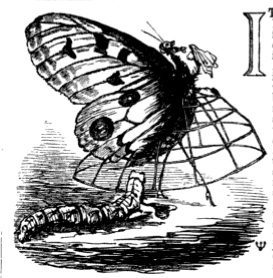Research Journal
-
May 18, 2009
Chillingham Cattle are Clones
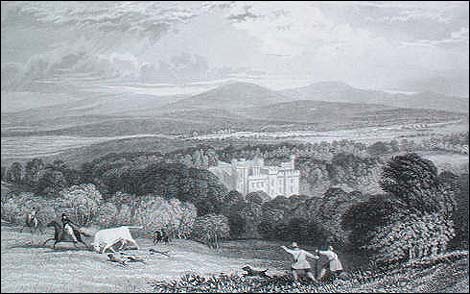
Nice overview of the cattle- history and genetics found at the BBC web site.
The cattle, who live in northern Northumberland, have been inbred for 700 years; in the 13th century the park around Chillingham Castle was enclosed to protect the cattle from the Border Reiver rustlers. These are wild cattle that have never been herded or driven, and have the status of wild animals. They are also genetically linked to the prehistoric Aurochs, extinct for 2500 years. And because of their long inbreeding, Chillingham cattle are all clones:In recent years DNA samples have been prepared from hair roots collected from dead animals and this work, at the Roslin Institute and Edinburgh University, has revealed that the Wild Cattle are a natural clone.
Not only are all the cattle genetically identical, each animal has also received identical genes from its sire as from its dam (the Y chromosome, which determines masculinity, is not possessed by female mammals, but again the likelihood is that all Y chromosomes in the Chillingham herd are identical).
“Nowhere in the world are there any mammals more inbred than these – yet they continue to survive and thrive.” – The Chillingham Wild Cattle Association
This is unique among animals, and arises from their very long history of inbreeding, together with occasional periods of very low numbers (genetic bottlenecks).
In spite of this genetic identity, it would be difficult to point out two animals that could be said to be identical.
This is because the visible characteristics of any animal (the phenotype) are partly determined by the environment and minor differences between individuals in patterns of development in the womb and afterwards can be expected.
Nowhere in the world are there any mammals more inbred than these – yet they continue to survive and thrive.
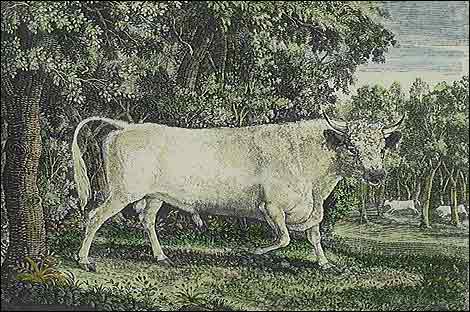
The Chillingham Bull. Both engravings by Thomas Bewick -
May 18, 2009
“Red squirrels,” she said, “are rather like quiet, well-behaved people.”
The article “The Squirrel Wars,” by D.T. Max, that ran in the NY Times in 2007 on the Red vs Gray struggle has a wonderful mid-section devoted to the House of Lords discussion on the subject. As a perhaps-important underscore, the House has cut hereditary peers’ membership by 90% in the recent decade.
Lady Saltoun of Abernethy, the 21st to hold that title in Scotland…spoke to point out the inherent superiority of the red over the gray squirrel: “Red squirrels,” she said, “are rather like quiet, well-behaved people who do not make a nuisance or an exhibition of themselves or commit crimes and so do not get themselves into the papers in the vulgar way gray squirrels do.” She continued: “Red squirrels do not strip bark from trees; damage arable crops, market gardens and garden plants; dig up bulb and corms from recently sown seed; eat birds’ eggs; or eat telephone wires and electricity cables, as gray squirrels do.” Lady Saltoun suggested some research be done on whether gray squirrels tasted good. She foresaw a fight at the dinner table: “I have a nasty feeling that . . . children in particular would say, ‘Oh, no, I couldn’t possibly eat that,’ just as they say they cannot eat dear little bunny rabbits. But this is worth having a look at.”
The Rt Hon. The Lady Saltoun (née Ms. Flora Fraser, me being a vulgar American) is the only female holder of a lordship of Parliament who has a seat in the House of Lords as an elected hereditary peer. She is the head of the Frasers of Philorth. (thanks Wikipedia). But her comments, while perhaps more focused on etiquette, are not anomalous among the peerage.
Here is Lady Saltoun’s web site.
She has a fantastic genealogy and has written the books “Clan Fraser,” “Lady Saltoun’s Favourite Fish Dishes,” and “Lady Saltoun’s Favourite Puddings.” -
May 17, 2009
A Nationalist takes red squirrel as mascot
Well! Sad but inevitable use of animals as symbols. The squirrel of course is cute and wonderful, and was at one time well-adapted and in balance with its native habitat. But c’mon – I’ve been keeping quiet and recording “just the facts” about the critters – and it wasn’t hard to find this unsurprising (lock)step:
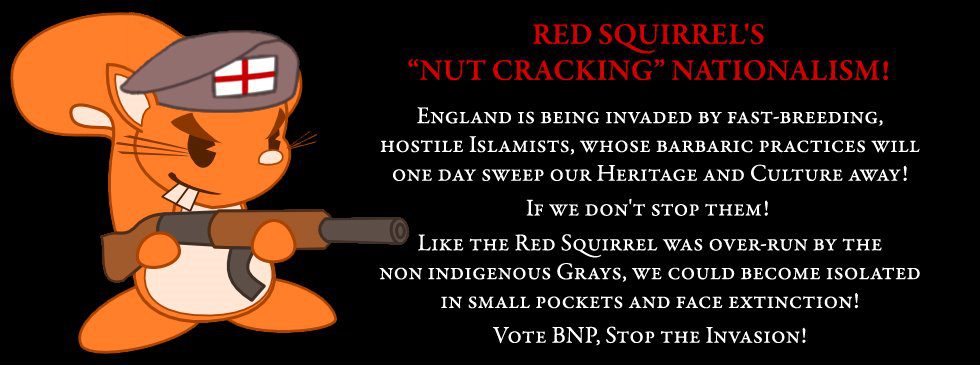
from the blog, Nationalism in Our Times of Need The author of this blog, code name Red Squirrel, writes,
I am proud to be a member of The British National Party. This photograph replaces the image of the Red Squirrel I used to conceal my identity from the disgusting hammer wielding fascist scum, that threaten to burn people alive! But I hide NO More!These people are reprobates, paid by the government and the Islamists to intimidate, silence or even kill freedom loving people who dare to raise their voices in protest. Please wake up Britain and vote For the only party able to halt this madness! We are descending into the horror of a repressive and totalitarian regime. I love my Nation. Do You? Our Civilisation once gone would be irreplaceable!
and this is quite a surprising profile photo (nice rainbow; is this mythic Britain?):

-
May 17, 2009
“Helping our reds to stand up for themselves”
+ + + +
22,586 Grey Squirrels trapped since January 2007
(statistic from the RSSP)+ + + +
This is a screen shot of the Northern Red Squirrels home page – a volunteer protection group:

http://www.northernredsquirrels.org.uk./ A link from their web site led me to an article in the Telegraph from April 2009, in which the Prince of Wales is quoted as follows:
The Prince will speak of his sadness at the decline of the “most utterly charming and irresistible of British native mammals” – the red squirrel – because of the spread of greys from North America.. He added: “I am incredibly fortunate to see red squirrels whenever I am in Scotland and I cannot bear the thought that one day they might disappear forever, driven out by the relentless march of the greys.” …”Our red squirrels are facing a battle for survival. It seems almost incomprehensible to me that we have allowed this situation to happen. The far bigger grey squirrels, which were only introduced into this country one hundred and thirty years ago are outcompeting the reds in every way, let alone infecting them with the appalling squirrel pox, to which they are immune, but to which the reds are particularly prone and die a lingering and agonising death.”
-
May 17, 2009
ÜR SQUIRREL
Sorry. I can’t stop myself. Here’s the best picture yet of a red squirrel. If ever there was a reason to protect the Reds, it’s their supersonic selfdom. Though this one looks wily enough to defeat the Pox.

from The Guardian. Photograph: Owen Humphreys/PA -
May 17, 2009
Thomas Bewick, Waiting for Death
In the manifold and often ugly ways people interrelate with animals, Bewick’s wood engravings portray the specifics of rural northern England at a time when conditions, politics and views toward the land and nature were changing (urbanization, privatization of land, and the disappearance of the commons). Bewick escapes nostalgia, although many of his tiny, delicate engravings are pastoral and sweet.
But at times Bewick makes an overt (and dear) statement of injustice. I found this image and decription on the Bewick Society web site :
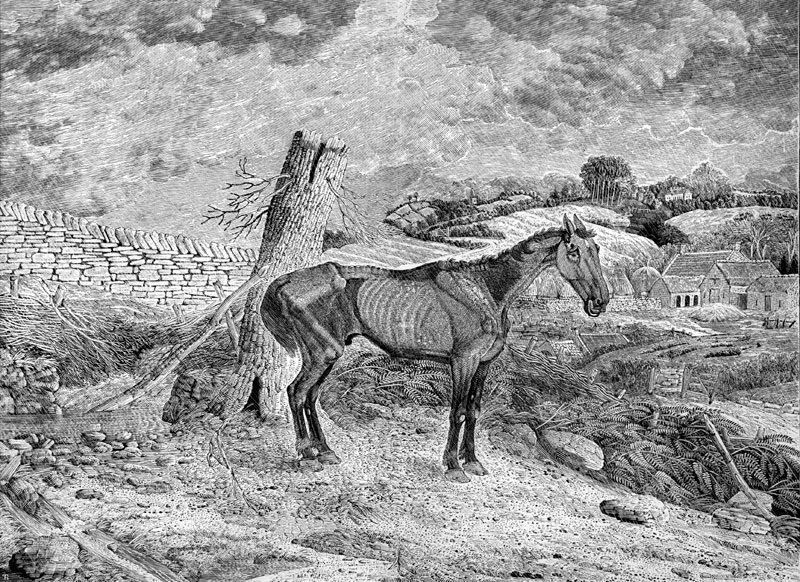
Thomas Bewick, "Waiting for Death," 1828 This single sheet print (8 3/4 x 11 1/2 inches) was the last piece Bewick worked on before he died. It was part of his experimentation in larger sized prints and it was not finished when Bewick died. It was published by his son Robert Elliott Bewick in 1832. The subject matter was identical to a much earlier vignette-sized print based on one of his earliest known drawings
[From the descriptive text written by Bewick to accompany the print Waiting for Death. The full text is in Robert Robinson, Thomas Bewick: His Life and Times, p. 163-4.]
In the morning of his days he was handsome – sleek as a raven, sprightly and spirited, and was then much caressed and happy. […] It was once his hard lot to fall into the hands of Skinflint, a horse-keeper – an authorised wholesale and retail dealer in cruelty – who employed him alternately, but closely, as a hack, both in the chaise and for the saddle; for when the traces and trappings used in the former had peeled the skin from off his breast, shoulders, and sides, he was then, as his back was whole, thought fit for the latter […] He was always, late and early, made ready for action – he was never allowed to rest.[…] It is amazing to think upon the vicissitudes of his life. […] But his days and nights of misery are now drawing to an end; so that, after having faithfully dedicated the whole of his powers and his time to the service of unfeeling man, he is at last turned out, unsheltered and unprotected, to starve of hunger and of cold.
His tail-pieces – small vignettes made to fill space at the bottom of pages – form an anecdotal field guide to Northumberland life. His wry and tender view, and his sensitivity to relations – of species, of class, of the built and natural world – are fully apparent throughout his engravings. These are not great reproductions – the ones in Jenny Uglow’s biography, “Nature’s Engraver” are fantastic, and merit reading with a magnifying glass at the ready.
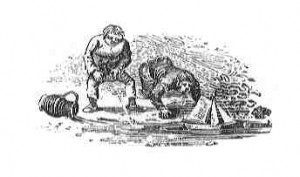
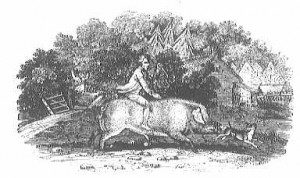
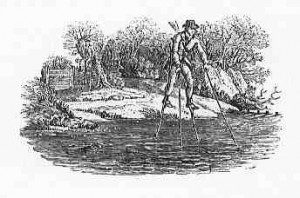
(tale-pieces from Tale-Pieces by Thomas Bewick)
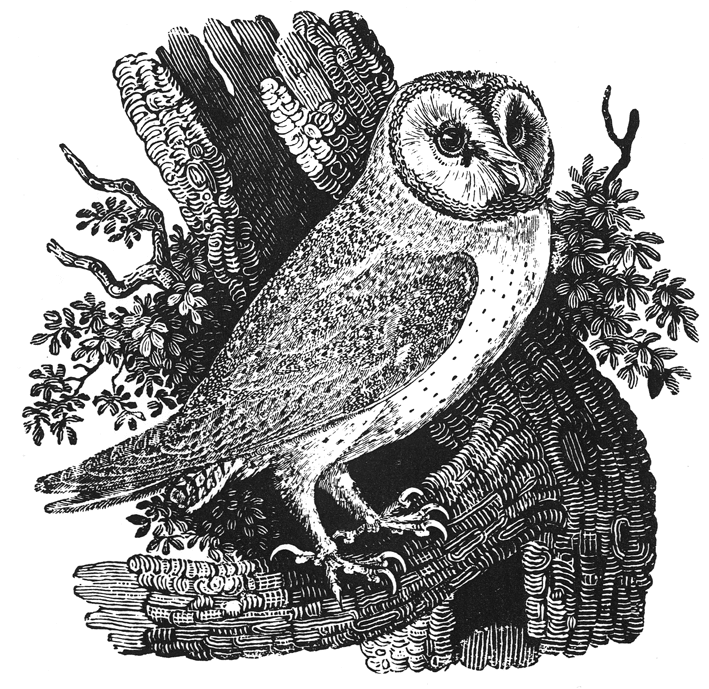
Barn Owl Tyto alba, from "A History of British Birds" (1816) -
May 13, 2009
Animals Roam the Streets of NYC
Tags:This in May 9, 2009, from the New York Times, courtesy Una Chaudhuri:
The history of animal escapes in New York City, collected in the archives of the city’s newspapers, reads like a feeding schedule at the Bronx Zoo — elephants, horses, wolves, bulls, monkeys, bears, goats, lions, deer and a six-foot boa constrictor named Minnie (captured in 1937 in Brooklyn)…
The tales of loose animals are odd little reminders of a lost era of the city, when there were monkey fanciers on the Lower East Side (loose monkey, July 1937) and when the site of the Hippodrome, now a sleek office building in Midtown with the same name, was home to a footloose elephant with a knack for the bass drum.
And this photo of Lucky Lady is from a 2007 escape in the Bronx, found in this article found on Associated Content.
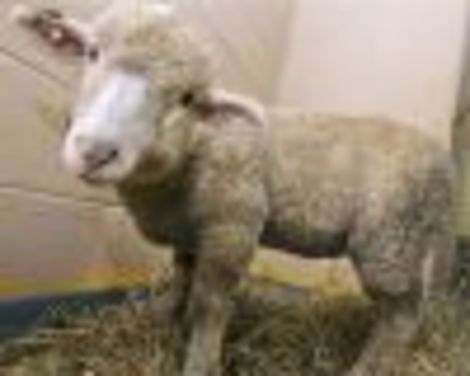
Lucky Lady (photo from AP) The lamb was just 7 months old and was on an escape attempt from a nearby market where live animals are sold eventually ending up as food. This little lamb’s escape plan has worked and instead of her sad fate will now head to her new home in upstate New York where she will live on a sanctuary.
-
May 10, 2009
National Insect Week
Well I’ll be; who knew?
The Royal Entomological Society, that’s who.
I am sad they only do even years – the next National Insect Week is in 2010
But they continue to host competitions like Close Encounters:
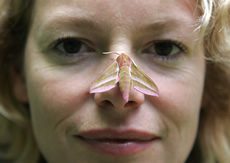
TV presenter Kate Humble has a ‘close encounter’ with an elephant hawk moth. Photo from http://www.nationalinsectweek.com/close_comp.php …and to offer loads of information on the National Insect Week web site.
There’s some great contextual material on insects as pollution indicators, on insect-friendly gardens, and on participating in insect surveys.
Seriously playful, and clearly in a long line of enthusiastic amateur naturalists. Here are some links –
The Royal Entomological Society hosts events, conferences, and publishes pamphlets + books like this one:
“A Year in the Lives of British Ladybirds,”
Iconically coloured, friends to farmers and gardeners alike, and named
after The Virgin Mary, Ladybirds are undoubtedly the most popular of all
the beetles…Written by three hugely experienced ‘ladybirders’, the book provides
instructions of how, when and where to find different species of ladybird,
how to identify the adults, and facilitates involvement in current research
projects on ladybirds. Excitingly, the book sets out ways in which readers
can contribute to national surveys of ladybirds, initiated as a result of the
recent arrival of the invasive alien harlequin ladybird in 2004. -
-
May 1, 2009
Pit Ponies
This image freaks me out, as well it should.

Pit pony being lowered into a mine from Wikipedia:
Ponies began to be used underground, often replacing child or female labour, as distances from pithead to coal face became greater. The first known recorded use in Britain was in the Durham coalfield in 1750. In later years, mechanical haulage was introduced on the main underground roads replacing the longer pony hauls (“driving”) and ponies tended to be confined to the shorter runs from coal face to main road (known in North East England as “putting”) which were more difficult to mechanise. As of 1984, 55 ponies were still at use with the National Coal Board in Britain, chiefly at the modern pit in Ellington, Northumberland. At the peak in 1913, there were 70,000 ponies underground in Britain.

Pit Pony stable underground. From several of my superficial trawls, it is said that the ponies were well-looked after (better than the men), as they were a more difficult to replace capital commodity. In some cases, the stables even had electric lights, and they were given treats from the miner’s lunches, to coerce them to work harder. But in many cases, the ponies would remain underground for as long as a year.
The last surviving pit pony, Pip, died in February 2009 at the age of 35.
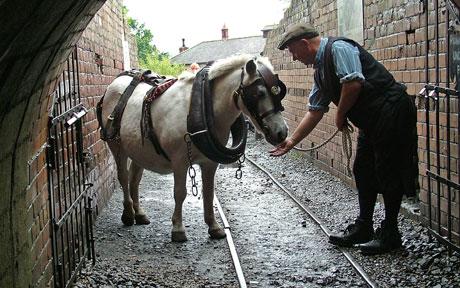
Pip, the retired pit pony He worked at Blackburn Drift, Marley Hill Colliery, near Sunniside, Gateshead, and then at Sacriston Colliery, near Durham, and retired in 1985 when the mine closed. he spent his last 23 years at Beamish (open air museum). I bet he felt pretty happy and surprised about that turn of event. Telegraph, February 2009
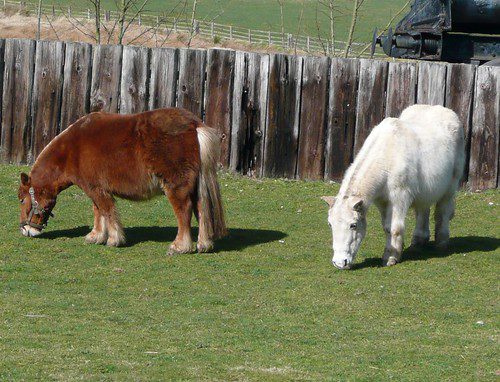
Pip at pasture at Beamish. Photo from flickr
